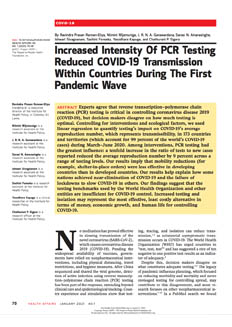Increasing PCR testing reduced COVID-19 cases and deaths, and it was the most important predictor of how well countries contained the pandemic. The study also found that lockdowns did not slow the virus in most countries, and that masks and school closures had less impact than high levels of testing and isolation.
Abstract
Experts agree that reverse transcription–polymerase chain reaction (PCR) testing is critical in controlling coronavirus disease 2019(COVID-19), but decision makers disagree on how much testing is optimal. Controlling for interventions and ecological factors, we used linear regression to quantify testing's impact on COVID-19's average reproduction number, which represents transmissibility, in 173 countries and territories (which account for 99 percent of the world's COVID-19cases) during March–June 2020. Among interventions, PCR testing had the greatest influence: a tenfold increase in the ratio of tests to new cases reported reduced the average reproduction number by 9 percent across a range of testing levels. Our results imply that mobility reductions (for example, shelter-in-place orders) were less effective in developing countries than in developed countries. Our results help explain how some nations achieved near-elimination of COVID-19 and the failure of lockdowns to slow COVID-19 in others. Our findings suggest that the testing benchmarks used by the World Health Organization and other entities are insufficient for COVID-19 control. Increased testing and isolation may represent the most effective, least costly alternative in terms of money, economic growth, and human life for controllingCOVID-19.

